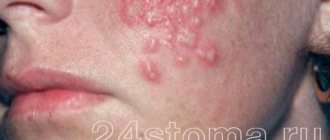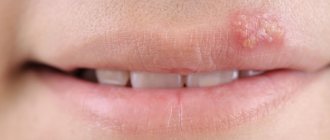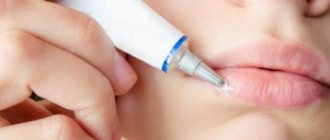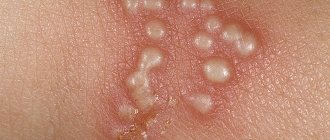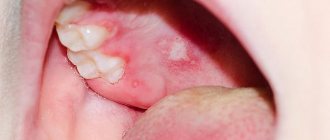Pediatrician Mikhail Nikolsky: Herpes - to treat or not to treat
Alexandra Petrovskaya: Good afternoon. This is a program for the biggest ones. With us in the studio is pediatrician and candidate of medical sciences Mikhail Nikolsky. Mikhail Andreevich, hello.
Mikhail Nikolsky: Good afternoon.
A.P.: We have gathered here today about your scientific work on herpes types 6 and 7. Let's try to explain to the listeners what it is, and, most importantly, where these types come from, and what other types - the first, second, third and so on - go up to 6 and 7.
M.N.: In total, there are 8 or 9 types of herpes, depending on how you count. The first and second types are common herpes, which causes cold sores on the lips. The third type is the herpes zoster virus, which causes chickenpox or shingles in adults.
A.P.: So what we call chickenpox is, in fact, the same herpes?
M.N.: Not the same, it’s a completely different herpes, but also herpes.
A.P.: By what principle are they all united under this name?
M.N.: It's difficult. When scientists studied the DNA of these viruses, it turned out that they all had similar related features. The fourth type, Epstein-Barr virus, causes infectious mononucleosis. The fifth type is what everyone knows as cytomegalovirus. These are also often infections, mostly for children.
And finally, type 6 and 7 are what I do. Most often they cause roseola in children - a three-day fever or sudden exanthema. Next comes the eighth type of herpes, it occurs in Kaposi's sarcoma. This is a serious disease that predominantly occurs in HIV-infected patients.
A.P.: Besides the common name and some similarities in DNA, what else unites them? Maybe there are common methods of therapy or similar effects of the virus on the body?
M.N.: Firstly, unlike many other viruses, there is a medicine against herpes. This is what makes these viruses different from others in many ways because there are no cures for a huge number of viruses.
A.P.: What about all these fashionable antiviral drugs that are advertised everywhere?
M.N.: Everything that is advertised on TV is, unfortunately, most likely fake.
A.P.: Fakes are prohibited.
M.N.: Fakes are prohibited, but, apparently, advertising of drugs without proven effectiveness is allowed.
A.P.: This is a topic for a separate program.
M.N.: This is a problem for our country, because in our country fakes have even found their way into clinical recommendations. And we treat people with all these “bullshit drugs.” Moreover, we are obliged to treat them, because we have appropriate clinical recommendations.
A.P.: Is someone lobbying for this?
M.N.: Of course, this is lobbied for, it is paid for. And what to take if, excuse me, we have one of the members of the Russian Academy of Sciences - a homeopath.
A.P.: In these words you can feel your contempt for homeopathy.
M.N.: From the point of view of a clinical physician, to some extent, yes, contempt, this is true.
Let's return to herpes. They have a unique feature. After a person becomes ill with a primary herpes infection, these viruses do not leave the human body. All herpes that a person encounters in life remain with him forever.
A.P.: I came across the statement that it is difficult to meet a person on Earth over 10 years old who does not have antibodies to one or another type of herpes.
M.N.: And not only antibodies, but even the herpes themselves. In almost all people after a certain age, one or another herpes can be found in saliva, blood or other tissues. This is the problem with diagnosing them - doctors very often get confused. Colleagues, out of ignorance, but with the best intentions, prescribe, for example, saliva tests for frequently ill patients for the Epstein-Barr virus, cytomegalovirus, herpes type 6, type 7, and find them in the saliva. And this is the norm.
A.P.: Are they starting to treat?
M.N.: Yes, absolutely right. The patient does not know that this is the norm. He sees that he has a “terrible” test, that such and such a number of these herpes have been found, and the doctor, most likely, out of ignorance and lack of understanding of this problem, begins to treat normal carriers of herpes. And what does he treat? He treats with the same fuflomycins. And nothing happens.
A.P.: Bottom line – there is no need to treat herpes?
M.N.: It is necessary if it caused a serious illness - and all herpes in certain cases can cause serious illnesses. For example, herpes type 6 is a common cause of severe conditions in patients after a bone marrow transplant. If herpes after a bone marrow transplant has worsened against the background of a decrease, the actual destruction of one’s own immunity, then therapy necessarily requires powerful antiviral agents.
Well, take chickenpox – it would seem a harmless disease. But after 11 years it is difficult and can have consequences. Therefore, it is believed that if the patient is under 11 years of age, it often goes away on its own. And if you are over 11 years old, then it is better not to risk it, but to prescribe acyclovir.
A.P.: Is this a drug with proven effectiveness?
M.N.: Yes, it acts specifically on the chickenpox virus.
A.P.: It turns out that herpes, which is always in the body, at some point gets worse. For example, I heard about herpes type 6, that this is a typical disease for children under 2-3 years of age. It turns out that no.
M.N.: The fact is that herpes type 6 is the most common infection that always causes sudden exanthema or three-day fever or roseola. In principle, it is a very understandable infection: the child has a high fever for three days, then a typical maculopapular rash appears. Within two days it disappears on its own and the person recovers.
The infection itself can occur even through an ordinary kiss, as happens with many herpes. That is, the virus can enter the child’s body through contact with the saliva of the mother, grandmother, or any adult, who are usually the carrier of all herpes. And so the child suffers this primary infection through the human herpes virus type 6, and after that the human herpes type 6 remains in this child forever. And it won’t go anywhere, and there’s no way to get rid of it.
But it needs to be treated only in one situation - if it has caused some kind of serious illness, which almost never occurs in healthy people. Only for severe immunodeficiencies, which usually occur during organ and tissue transplantation. There are situations when intensive treatment of herpes type 6 is required.
In all other cases, there is no need to shock-treat it. And we must keep in mind that herpes is a very fashionable topic now. Herpes virus type 6 is easy to find, which means it can be presented for almost any disease as a possible diagnosis. And many doctors use this. For example: “I don’t know what’s wrong with you. Let’s look for what you definitely have.” And here is herpes type 6 - it definitely exists, and it is there.
A.P.: Another such moment. What other diseases can be associated with herpes viruses that are present in the body?
M.N.: As I already said, herpes types 6 and 7 “classically” cause roseola in children. Herpes type 6 and sometimes, but rarely, type 7 are also associated with febrile seizures in children. There are studies that show a connection between certain types of epilepsy and human herpes virus type 6. So it turns out that herpes type 6 actually causes a type of epilepsy.
A.P.: This virus is present in almost everyone’s body, but not everyone has epilepsy. That is, this suggests that there is no direct connection; there are other factors influencing the appearance of this disease?
M.N.: Of course, there are many factors here. For example, two people caught the same infection: but one had a runny nose, and the other had meningitis. But the infection is the same. Of course, there are many factors involved.
There was also a study that associated human herpes viruses 6 and 7 with other diseases, suggesting a link with multiple sclerosis. But this has not been proven. This is already a field of science, but we do not have clear indications that herpes is exactly what causes multiple sclerosis.
A.P.: During the program, we talked briefly about all herpes and outlined all the important points. And, concluding the conversation, I want to return to the beginning. What questions does science face today in this area?
M.N.: By the way, I forgot to say that a special form of human herpes type 6 is the chromosomal integrated form of this virus, when herpes type 6 is introduced into the human chromosome and begins to be inherited by all generations.
Now we have received a grant in St. Petersburg. We conduct free examinations of everyone for certain indications for the presence of chromosomally integrated human herpes type 6. It is precisely the presence of chromosomally integrated human herpes type 6 that may provide links with certain diseases. It turns out that almost 1% of the world's population has a chromosomally integrated virus built into its genome.
A.P.: Okay. Remembering my student years, what hypothesis do you have in this scientific research? If something, then what?
M.N.: We are currently recruiting a reference group, we are looking for people, we are examining them. I personally am now most interested in whether there are clinical manifestations of chromosomal integration of human herpes type 6 in newborns. In my opinion, this is the most interesting concept; no one in the world has yet developed this direction. So far there are preliminary results, but I’m not ready to announce them yet.
A.P.: Our guest was Mikhail Nikolsky, a pediatrician and candidate of medical sciences. Thank you and have a nice day everyone!
HERPETIC INFECTION
You chavoy are out of your mind!
There's a pimple on my lip!
L. Filatov
Herpes infection is not a specific disease. This is a term that unites a whole group of diseases and requires some clarification.
Viruses, like all other organisms, are divided by scientists into families, genera, and individual species. Currently, about 80 similar representatives of the herpes virus family have been discovered in nature, 7 of them isolated from humans.
These viruses, although similar to each other, cause diseases that are very different in terms of timing, clinical manifestations, and danger to the human body. By the way, we have already met three diseases - not at all similar, but they are all caused by viruses of the herpes group. These are chicken pox, sudden exanthema and infectious mononucleosis, just discussed.
The time has come to talk about a special virus, perhaps the most widespread, capable of causing a wide variety of diseases, sometimes deadly. It is called “herpes simplex virus”.
According to numerous studies, from 65 to 90% of all inhabitants of planet Earth are infected with the herpes simplex virus! Infection occurs in childhood, by contact or airborne droplets, and by the age of 6, about 80% of children already have the herpes virus in their bodies.
The virus, as it should be, penetrates inside the cells and remains there in an inactive state for life - that is, if infection with the virus has occurred, no medicine can completely get rid of it. But there seems to be nothing wrong with this - an inactive virus does not cause any particular harm. At the same time, if certain accompanying conditions occur, accompanied by a decrease in immunity (cold, other infectious disease, stress, physical fatigue, malnutrition, lack of vitamins, injury, etc.), the virus seems to wake up, begin its dirty work and cause illness .
One of the most typical manifestations of herpes simplex is a rash on the lips, more precisely at the border of the skin and the lip itself. People simply call these itchy blisters “fever.” It is easy to notice that in some people (children) these same fevers occur often, in others - very often, in others - they never occur. It all depends on immunity, on the general level of health of a particular person.
We have already written several times about the main nonspecific antiviral protein - interferon. The fact is that the body reacts differently to each virus, producing a certain amount of interferon. In the language of scientists, each virus has “individual interferonogenic activity,” and readers will forgive me for my very clever words. The particular “harmfulness” of the herpes simplex virus lies precisely in the fact that it hardly stimulates or to a very small extent stimulates the production of natural interferon. Hence the instability and insufficiency of immunity, frequent repetitions (relapses) of the disease.
“Fever” on the lips is still the flowers of the herpes simplex virus. Manifestations of the disease can be much more serious - eye damage, widespread lesions of the skin and oral mucosa (stomatitis), extensive rashes on the genitals (so-called genital herpes), pneumonia and the most terrible manifestation of infection - herpetic encephalitis - severe inflammation of the brain with unpredictable, but, as a rule, very sad consequences.
- The severity of any manifestations of herpetic infection is determined, first of all, by the state of the immune system! Once again we have to pay attention to the fact that the main method of prevention is a natural lifestyle that ensures the normal functioning of the immune system.
- Currently, there are drugs that can selectively suppress the reproduction of herpes viruses in the human body. The most famous is acyclovir (synonyms are herpevir, virolex, zovirax), and its appearance is the same revolution in medicine as the discovery of penicillin. Acyclovir is used topically, to treat rashes (ointments, creams, jellies), courses of treatment (sometimes very long) are carried out with tablets, and for herpetic encephalitis and other particularly severe variants of the disease, the drug is administered intravenously.
- Treatment of herpes infection usually involves the use of interferon. Not those well-known and relatively cheap nasal drops, but expensive and truly effective forms of interferon that are administered by injection. In addition, special medications are used that repeatedly increase the production of interferon in the body (cycloferon, neovir).
- Herpetic infection, and this is obviously curable. It is impossible, as we already understood, to completely eradicate the virus, but forgetting about its existence is quite possible. The main drawback of all methods of treating herpes infection without exception is the discrepancy between the income of our compatriots and the cost of effective medicines.
- The difficulty of treating herpes infection is not only the cost of medications. The treatment is long-term, carried out according to certain schemes that take into account the state of immunity, concomitant diseases, and the variant of infection. Parents just need to know the main thing: “herpetic little things” - like blisters on the lips - can sooner or later turn into a more serious problem, and herpes is not a sore when self-medication can lead to success. Hence the urgent need for consultation with a competent specialist and a full examination.
author Komarovsky E.O. book Child's health and the common sense of his relatives published 02/24/2010 18:40
When fatigue is a sign of herpes...
Herpes virus type 6 (HHV-6 or HHV-6) was discovered back in 1986. In 2012, a sensational discovery occurred: it turns out that the herpes virus type 6 in adults may not manifest itself in any way, but can still cause a painful condition
Where does it come from?
According to various sources, about 80% of people are infected with herpes virus type 6. Most often, the infection occurs in early childhood - between the ages of 6 months and 2 years. This is due to the child’s loss of maternal immunity and the high prevalence of the virus. The first meeting can occur in the form of roseola - a sharp increase in temperature, after which a rash appears after 3-4 days. This is the only specific manifestation in children that can be used to suspect HHV-6.
Alas, once in the body, any herpes virus will not leave it. In most people, the immune system quite successfully suppresses the development of herpes virus type 6. Continuing to live in the body, but does not affect anything. But this does not happen for everyone.
Always exhausted
Chronic fatigue syndrome (CFS) has long been considered an independent disease. This is not the kind of fatigue that can be “cured” by vacation, a change of job, or just normal sleep. CFS is diagnosed when a person experiences persistent fatigue and a 50% or more decrease in performance for 6 months or more. In this case, there are signs of chronic infection: low-grade fever, enlarged lymph nodes, muscle and joint pain, chronic pharyngitis, headaches.
Sleep disturbances, depression, irritability, difficulty concentrating, memory and intelligence deterioration often occur. Sometimes appetite disappears, a person suddenly loses or gains weight, problems arise in the stomach, intestines, and urinary system. Moreover, allergy symptoms or sensitivity to bright light, alcohol, medications, etc. may appear.
Before receiving a diagnosis of chronic fatigue syndrome, a person must undergo examination to rule out other diseases. Often the only objective sign of infection is the identification of herpes type 6
How to find out?
At the stage of making a diagnosis or to clarify it, doctors prescribe a laboratory test Antibodies to the herpes virus type VI (Herpes simplex virus VI), IgG. You can take it yourself if you are concerned about decreased performance, and then consult a doctor. For him, it is enough to donate blood in the laboratory 3 hours after eating or in the morning on an empty stomach.
Any decrease in immunity can trigger HHV-6 to become active. Most often it is triggered by stress, flu, or exacerbation of a chronic infection. Often people associate a tired-depressive state with a consequence of illness or stress, but in fact they have become a trigger for the activation of the virus. The active virus lives and multiplies at the expense of lymphocytes - the main cells of the immune system. Therefore, symptoms of infection and damage to the nervous system, which is closely related to the immune system, arise. When the HHV6 virus is activated, it can be detected by PCR in oropharyngeal scrapings or in urine. If there are skin rashes and fever, then herpes virus type 6 can be detected in the blood.
Who will need it?
Doctors identify several groups of patients who need testing Antibodies to the herpes simplex virus VI, IgG, or detection of herpes viruses in an oropharyngeal smear. These are the people who are concerned about:
- memory problems, inability to concentrate on business;
- causeless pain and sore throat;
- soreness of the lymph nodes in the neck and under the ears for an unknown reason;
- muscle pain not associated with physical activity;
- joint pain that has no objective cause (trauma, osteochondrosis, etc.);
- headaches that have never happened before;
- sleep problems;
- weakness and exhaustion after physical activity, clearly not corresponding to the expenditure of effort;
- frequent colds
- feeling of fever or chills at normal temperature
How to treat?
Antiviral drugs for other types of herpes can also be effective for HHV6 infection; the choice of treatment available in Russia is up to the attending physician (different antiherpetic drugs are registered in different countries). Therefore, symptomatic treatment plus boosting immunity is mainly carried out.
Despite all this, type 6 herpes virus is not a death sentence. You can live with it once your immune system can get it under control. Surprisingly, a healthy lifestyle can be of great help in this regard. It is imperative to improve your sleep: for those who sleep less than 6 hours a day, the risk of developing CFS is several tens of times higher.
Get tested on time, and treatment will be the least expensive!
WHAT YOU NEED TO KNOW ABOUT HERPES SIMPLE
Key Facts
There are two types of herpes simplex virus: herpes simplex virus type 1 (HSV-I) and herpes simplex virus type 2 (HSV-II).
HSV-I herpes on the lips and facial area
transmitted primarily through oral contact and causes oral herpes (symptoms of which may include a “fever sore”), but can also cause genital herpes.
HSV-II herpes in the genital area
is one of the sexually transmitted infections and causes genital herpes.
More than 90% of the world's population are carriers of the herpes virus. Infection with both HSV-I and HSV-II lasts for life.
The frequency of herpes on the lips varies from person to person and can recur from 2 to 12 times a year. Most cases of herpes are oral and genital.
Typically, the virus settles in the body at 3-5 years of age, but does not appear until puberty.
Transmission routes:
- Autoinfection.
The virus is transmitted from infected areas of the body to uninfected areas. For example, contact lens wearers can transfer the herpes virus to the eye area by wetting the lenses with infected saliva instead of a solution.
- When contacting another person through a kiss
For infection to occur through a kiss, the virus needs 2 conditions:
so that the carrier has an active phase of herpes (moreover, it can be asymptomatic)
so that the partner has a predisposition to infection: an abundance of saliva, small wounds.
- Upon contact with a contaminated surface
The virus is able to survive for some time outside its host: in a humid environment, at a temperature of 37°. That is, it is possible to become infected by drinking from the same glass or using the same lipstick. It is theoretically possible, but rare, to become infected with genital herpes when sitting on plastic surfaces (toilet, locker room bench), because On plastic surfaces under favorable conditions, the virus survives for about 4 hours.
Stages of herpes
Precursor stage
It usually begins with a tingling, itching and burning sensation on the lips. Duration from several hours to 1 day.
Hyperemia stage
Literally on the same day as the tingling sensation, swelling and redness of the lip occurs. The condition is usually accompanied by itching and lasts on average 1-2 days.
Bubble stage
A group of several bubbles is formed, which merge with each other into one painful bubble filled with lymph. This usually happens on the second day and is accompanied by very painful sensations.
Stage of erosion formation
On day 3, the blisters transform into ulcers and pustules, which then form a sore. Usually it is gray in color with a bright red ring around it. The liquid released from the sore contains virus particles in a concentration of 1 million per 1 ml. and is highly contagious
Crust formation stage
From days 4 to 9, the sore dries out and crusts over. In this case, the pain becomes less, but severe itching appears. The sore may fall off in parts and bleed. Herpes begins to heal from the inside, the sore becomes smaller.
Healing stage
On days 9-11, the wound heals and heals. However, redness may persist for another two days. During this period, the virus returns to a dormant state, in which it can remain until it is activated again by risk factors.
Treatment
The most effective medications for people infected with HSV are antiviral drugs such as acyclovir, famciclovir and valacyclovir. They help relieve symptoms and reduce the frequency of their occurrence, but do not lead to a complete cure.
Prevention
HSV-I herpes on the lips and facial area
HSV-I is most contagious during the onset of oral herpes symptoms, but it can also be transmitted when no symptoms are felt or observed. Individuals with active symptoms of oral herpes should avoid oral contact with others and sharing objects that have come into contact with saliva. They should also abstain from oral sex to prevent herpes from spreading to their partner's genitals. People with symptoms of genital herpes should avoid sexual intercourse while they are experiencing symptoms.
Consistent and correct use of condoms can help prevent the spread of genital herpes. However, condoms can only reduce the risk of infection, since symptoms of genital herpes can appear in areas not protected by a condom.
Individuals already infected with HSV-I cannot become infected again, but they remain at risk of infection with HSV-2, which affects the genital area.
Pregnant women with symptoms of genital herpes should inform health care providers. Preventing new infections with genital herpes virus is especially important for women in late pregnancy, since this is the period when the risk of developing neonatal herpes is highest.
HSV-II herpes in the genital area
People with a genital infection caused by HSV should abstain from sexual activity while symptoms of genital herpes appear. HSV-II is most contagious when lesions appear, but it can also be transmitted when no symptoms are felt or observed.
Systematic and correct use of condoms can help reduce the risk of spreading genital herpes. However, condoms provide only partial protection because HSV can be found in areas not protected by a condom. Medical male circumcision can provide men with lifelong partial protection against HSV-II, as well as HIV and human papillomavirus (HPV).
Individuals with symptoms suggestive of genital HSV infection should be tested for HIV infection, and those living in areas with high HIV prevalence should be offered more focused HIV prevention interventions, such as pre-exposure prophylaxis.
Pregnant women with symptoms of genital herpes should inform health care providers. Preventing new infections with genital herpes virus is especially important for women in late pregnancy, since this is the period when the risk of developing neonatal herpes is highest.
Herpesvirus infections in children: modern treatment options
In recent years, herpes viruses have occupied a special place among the main causative agents of viral infections in children, which is associated with their widespread distribution, wide diversity, multiple organ lesions, variety of clinical manifestations, as well as a high frequency of chronicity. Herpes-associated diseases are among the most common and poorly controlled human infections. This is due to the fact that herpes viruses can circulate for a long time asymptomatically in the body of a person with a normal immune system, and with immunosuppression, contribute to the development of severe diseases, including life-threatening generalized infections. Thus, according to the World Health Organization (WHO), the mortality rate from herpes infection is about 16% and is in second place after hepatitis among viral diseases [1].
Herpes viruses (from the Greek ?ρπειν (herpein) - to crawl) are a family of DNA viruses, united in the Herpesviridae family, which includes 8 classified types of human viruses: herpes simplex viruses - herpes simplex virus (HSV-1) and genital herpes (HSV-2), varicella-zoster virus, Epstein-Barr virus, cytomegalovirus, human herpes virus types 6, 7, 8, as well as about 80 unclassified human and animal herpes viruses. The subfamily of α-herpes viruses includes HSV-1, HSV-2 and varicella zoster virus, which are characterized by rapid replication in various cell types and have a cytopathic effect on infected cell cultures. Beta herpes viruses (cytomegalovirus, herpes viruses types 6 and 7) also affect various types of cells, lead to an increase in their size (cytomegaly), and can contribute to the development of immunosuppressive conditions. The subfamily of γ-herpes viruses includes Epstein–Barr virus and herpes virus type 8 - Kaposi's sarcoma-associated virus (KSHV). They are characterized by tropism for lymphoid cells (T- and B-lymphocytes), in which they can persist for a long time. In some cases, they can cause the development of lymphoma and sarcoma [2].
For the synthesis of viral proteins and the formation of the virus envelope, its capsid and the DNA of “daughter” virions, amino acids, lipoproteins and nucleosides of the host cell are required. As intracellular reserves are depleted, these molecules enter the infected cell from the interstitial spaces. Due to the fact that herpes viruses directly depend on the intensity of intracellular metabolism in the human body, they colonize predominantly the cells of the epithelium, mucous membranes, blood and lymphoid tissue, which have the highest metabolic rate.
Virions of herpes viruses are thermolabile - they are inactivated within 30 minutes at a temperature of 50–52 °C, within 20 hours at a temperature of 37.5 °C, but tolerate lyophilization well. On metal surfaces (coins, door handles, water taps) herpes viruses survive for 2 hours, on plastic and wood - up to 3 hours, on wet medical materials (cotton wool and gauze) - until they dry at room temperature (up to 6 hours ). The uniqueness of herpes viruses lies in the fact that they are capable of continuously or cyclically multiplying in infected cells of tropic tissues (persistence), as well as being preserved for life in a morphologically and immunochemically modified form in the nerve cells of regional nerve ganglia (latency) and being reactivated under the influence of various exogenous agents. and endogenous provoking factors. However, the ability for persistence and latency varies among different strains: the most active in this regard are herpes simplex viruses, the least active is the Epstein-Barr virus.
According to numerous studies, by the age of 18, more than 90% of urban residents are infected with one or more strains of viruses. The main route of infection is airborne, through direct contact or through household items (shared dishes, towels, handkerchiefs, etc.). Oral, genital, transfusion, transplantation and transplacental routes of transmission of infection are also noted. HSV types 1 and 2, cytomegalovirus are among the causative agents of TORCH infections, contributing to the development of serious diseases in newborns and young children. Herpes simplex viruses, cytomegalovirus, and Epstein–Barr virus are considered indicators of AIDS due to their frequent detection in this disease [3, 4]. The development of chronic fatigue syndrome (CFS) is associated with herpes viruses [5].
Clinically, herpes infection in children can occur in the form of chickenpox (varicella-zoster virus), infectious mononucleosis (Epstein-Barr virus), sudden exanthema (human herpes virus types 6 and 7), aphthous stomatitis (HSV 1 or type 2), mononucleosis-like syndrome (cytomegalovirus). In adolescents and adults, the infection is often asymptomatic, which is explained both by the biological properties of the strains and by the individual characteristics of the immune response. Often, when the body’s immunoreactivity decreases, herpes viruses act as opportunist viruses, leading to a more severe course of the underlying disease and the development of complications. The role of herpesvirus infections, especially cytomegalovirus, in the formation of infant mortality is great. The greatest threat to the life and health of children is posed by herpetic neuroinfections - their mortality rate reaches 20%, and disability - 50%. Ophthalmoherpes (development of cataracts or glaucoma - up to 50%), genital herpes, and a generalized form of Epstein-Barr virus infection (infectious mononucleosis) are severe [1, 6].
Herpes virus infection is a difficult to control disease. Despite the variety of medications used to treat this pathology, there is no means of providing a complete cure. This is due to the genotypic characteristics of the pathogen, the formation of resistance of herpes viruses and molecular mimicry.
The mechanisms of replication of herpes viruses discovered using molecular biology methods, as well as the study of the interaction of the virus with the cell, have made it possible to create a number of effective chemotherapeutic agents with antiherpetic activity. However, while effectively stopping acute manifestations of infection, they do not prevent relapses and do not always reduce the frequency of relapses.
Considering that with herpes-associated infections, as with other chronic diseases with long-term persistence of the virus, immunodeficiency states develop, in order to increase the effectiveness of treatment, treatment regimens, along with antiviral drugs, must include drugs that help correct the patient’s immune status. All this dictates the need to correctly select the drug, its dose and duration of administration, and, if necessary, use a combination of different drugs, while avoiding polypharmacy. A certain complexity of therapy in childhood is caused by age restrictions for a number of drugs, the presence of adverse drug reactions (ADRs) and contraindications.
Currently, the following groups of drugs are used to treat herpesvirus diseases and prevent relapses (table).
When treating herpes infections, an integrated approach should be followed. The duration and intensity of therapy are determined by the patient’s age, the clinical form of the disease, the severity of its course, as well as the presence of complications and concomitant pathologies. Treatment and preventive measures should be divided into several stages.
- Acute period of illness (relapse) - protective regimen, therapeutic nutrition, antiviral drugs, interferons and their inducers. According to indications, immunoglobulins, antibacterial drugs of local and systemic action, glucocorticoids, neuro- and angioprotectors, hepatoprotectors, cardiotropic drugs, protease inhibitors are prescribed. Symptomatic therapy may include antipyretic, expectorant and mucolytic drugs.
- Remission, subsidence of the main clinical manifestations (immunomodulators, adaptogens of plant origin, pre- and probiotics, vitamin-mineral complexes).
- Prevention of relapses (specific prevention - vaccination, sanitation of chronic foci of infection, restoration of immune status, etc.).
It should be noted that the combined use of antiviral drugs and immunobiological agents has a number of advantages. Firstly, complex therapy provides a synergistic effect. Secondly, it allows you to reduce the dose of an antiviral chemotherapy drug, reducing the likelihood of developing ADRs, reducing its toxic effects on the body and reducing the likelihood of the emergence of resistant strains of herpes viruses. In addition, it significantly reduces the duration of the acute period of the disease and the treatment time.
One of the drugs that has shown its effectiveness in the treatment of herpes-associated diseases in children is inosine pranobex. Inosine pranobex is a synthetic complex purine derivative with immunostimulating activity and nonspecific antiviral effect. The drug restores the functions of lymphocytes in conditions of immunosuppression, increases blastogenesis in the population of monocytic cells, stimulates the expression of membrane receptors on the surface of T-helpers, has a stimulating effect on the activity of cytotoxic T-lymphocytes and natural killer cells, the functions of T-suppressors and T-helpers, increases the production of immunoglobulin G, interferons, interleukins (IL-1 and IL-2), reduces the formation of proinflammatory cytokines (IL-4 and IL-10), potentiates the chemotaxis of neutrophils, monocytes and macrophages. The mechanism of the antiviral action of the drug is associated with the inhibition of viral RNA and the enzyme dihydropteroate synthetase, which is involved in replication, enhancing the synthesis of lymphocyte mRNA suppressed by viruses, which is accompanied by inhibition of the biosynthesis of viral RNA and the translation of viral proteins.
Inosine pranobex is low toxic, well tolerated, in Russia it is recommended in the form of tablets for children from 3 years of age (body weight more than 15 kg). Abroad, it is also available in syrup form and has no age restrictions. The drug is prescribed at 50–100 mg/kg/day orally in 3–4 doses throughout the entire acute period of the disease (5–10 days, depending on the duration of viremia and the severity of the intoxication syndrome). As maintenance therapy to restore immunological parameters, it is possible to prescribe the drug according to an immunomodulatory regimen (50 mg 2 times a day for 14–28 days). The high effectiveness of course therapy with inosine pranobex (50 mg/kg body weight per day in 3-4 doses orally, three courses of treatment for 10 days with an interval of 10 days) [7], combined course therapy using inosine pranobex and recombinant interferon α- 2β (3 courses of 10 days with an interval of 14 days) in children with mixed viral infections [8].
The use of inosine pranobex as a drug with immunotropic and antiviral effects at various stages of treatment and prophylactic measures allows one to avoid polypharmacy, thereby reducing the drug burden on the body and reducing the risk of undesirable effects.
Literature
- Kuskova T.K., Belova E.G. The family of herpes viruses at the present stage // Attending Physician. 2004, No. 5, p. 64–69.
- Hjalgrim H., Askling J., Rostgaard K. et al. Characteristics of Hodgkin's lymphoma after infectious mononucleosis // N. Engl. J. Med. 2003; 349:1324–1332.
- Nikolsky I. S., Yurchenko V. D., Nikolskaya K. I. Characteristics of active chronic Epstein–Barr viral infection: clinical and immunological syndrome // Modern infections. 2003, No. 3, p. 60–62.
- Katz BZ, Shiraishi Y., Mears CJ, Binns HJ, Taylor R. Chronic fatigue syndrome after infectious mononucleosis in adolescents // Pediatrics. 2009, Jul; 124(1):189–193.
- Lerner AM, Begar SN, Deeter RG IgM serum antibodies to Epstein-Barr virus are uniquely present in a subset of patients with the chronic fatigue syndrome // In Vivo. 2004, Mar-Apr; 18 (2): 101–106.
- Maakaroun NR, Moanna A., Jacob JT, Albrecht H. Viral infections associated with haemophagocytic syndrome // Rev. Med. Virol. 2010, Mar; 20 (2): 93–105.
- Simovanyan E. N., Denisenko V. B., Grigoryan A. V. The effectiveness of the use of inosine pranobex in frequently ill children with chronic Epstein-Barr viral infection: results of a randomized study // Issues of modern pediatrics. 2011, T. 10, No. 2, pp. 16–21.
- Nesterova I. V., Kovaleva S. V., Chudilova G. A., Lomtatidze L. V., Kleshchenko E. I., Shinkareva O. N. Dynamics of changes in the phenotype and functional activity of neutrophil granulocytes in immunocompromised children with repeated acute respiratory viral infections, associated with herpesvirus infections, against the background of combined interferon and immunotherapy // Cytokines and inflammation. 2014, T. 13, No. 1, p. 113.
T. A. Bokova, Doctor of Medical Sciences, Professor
GBUZ MO MONIKI named after. M. F. Vladimirsky, Moscow
Contact Information
